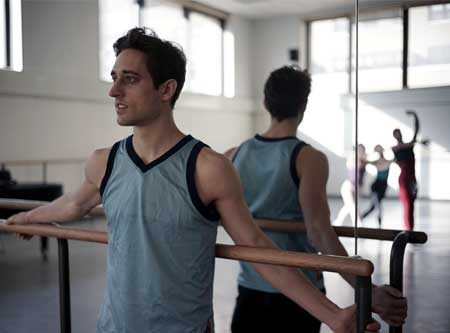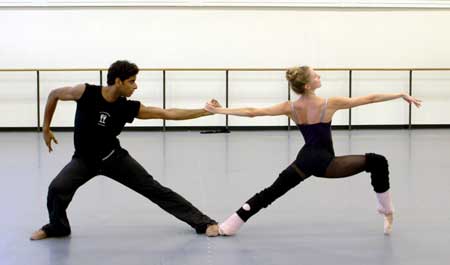Film (2015)
Directed by Jody Lee Lipes
Cinematography by Nick Bentgen and Jody Lee Lipes
Film Editing by Saela Davis
Kendall Square Cinema, Cambridge, MA
With Justin Peck, Tiler Peck, Sterling Hyltin

in “Ballet 422”
Photo: Courtesy of Magnolia Pictures
As the opening text of this documentary film clearly delineates, Justin Peck, at age twenty-eight, is a member of the Corps de Ballet at the New York City Ballet, which it describes as the most humble part of the troupe. (Never mind that most dancers would kill to even approach being admitted to the Corps de Ballet of this esteemed organization.) We watch as he prepares for his “ordinary” role in that lineup, dolling himself up with makeup, blow-drying and spraying his pomapdour, stretching with other members of the Corps, and doing what any dancer would do to prepare just before a concert.
It turns out that, in addition to being “just” an ordinary dancer, Peck has also been selected to choreograph a new work for the New York City Ballet. Initially teasing one into thinking that this fellow primping and loosening up before a performance is a regular member of the company, the film then lures one into seeing him in his new, magisterial, albeit temporary, role as a uniquely prized innovator.
This interesting documentary is fun to watch and, as far as it goes, gives a sense of how a new dance is constructed. It is short – about seventy-five minutes – and is particularly valuable for delivering a compelling sense of the great opportunity Peck has been given while offering a peek through a window into his creative process.

in “Ballet 422”
Photo: Courtesy of Magnolia Pictures
That peek is alluring, but the account of the development of the choreographic ideas is more suggestive than elaborated. One watches Peck work with one of the principal dancers to evolve his conception, a very compelling segment while it lasts. If there were more of that demonstration of the construction of the work in detail, this film would have been that much more instructive. It provides a seductive taste of the ideas, but it is more anticipatory and episodic than comprehensive.
As well, one sees pieces of the performance as it comes to life, and they, indeed, are impressive. As well, if there were a more consistently presented account of the performance that too would have been welcome. One gets a feel for the final product, but, again, mostly just that.
The film is most successful in delivering its subtext: that an artist who appears quite ordinary in one context can appear quite extraordinary in another. Seeing Peck just as a member of the troupe, one would not think him distinctively talented. When, however, one sees the ingenuity with which he creates this new ballet, one is pretty much blown away by his creativity.
The title of the film signifies that this new work, Paz de la Jolla, is the 422nd that the New York City Ballet will put into its repertoire. The account of the gestation of this piece, and of the birth and nurturing of a new choreographic talent, is inspiring. Though entertainingly informative as a glimpse, a somewhat more comprehensive story about Peck, about the company, about the challenges of choreography, and a more intensive look into the details of this piece, would have yielded a somewhat more persuasive cinematic tribute.
Charmingly, at the end, the film returns Peck to his “ordinary” role as dancer, a sweet reconsideration, a lovely recapitulation, of how, in so many contexts, routine and distinctive roles interleave and support one another.
– BADMan
Leave a Reply